Day 2 – Saturday, September 25, 2010
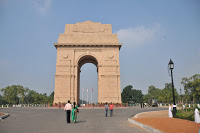
Today we started with a hearty breakfast and then headed for the slums of Delhi to meet with two families. Usha, Krish and I met with our colleague Indira, president of the Delhi chapter, HFI, who would guide us. But first a bit of sightseeing. Krish had never before been to Delhi! It’s a marvelous city, alternatively orderly and clean, then also, like most big cities, chaotic, noisy and dirty. We toured the India Gate, a stately monument to the fallen Indian soldiers of several wars.
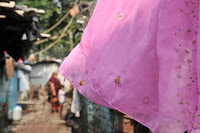
The first family we visited was in a ramshackle riverside slum, sheltered underneath a soaring highway. A sea of blue plastic tarp draping the tops of the many shanties rippled. Parking on the roadside, we stepped gingerly on a beaten path littered with dog, pig and human excrement, and plastic bags, garbage and paper. A ghastly smell rose from the heavily polluted river, causing Krish to cover his mouth with a handkerchief. Up ahead we could see small children scuttling about, a few teens, and many women: bathing the children under an open spigot by the riverside, hanging laundry, cooking over open fires or carrying supplies home. The dwellings are cement blocks, covered by corrugated tin sheets and covered by the blue tarp to prevent rain from dripping in. An enormous sow rolled over in the mud to allow her numerous piglets to suckle while strange looking stray dogs sauntered by, short-haired, wary, thin, and dirty.
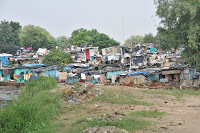
I generate a lot of curious stares, but you know what? If you smile and say “Namaste,” putting your hands together in prayer (the traditional greeting) almost everyone smiles. One young girl—so hard to believe she lives there—not only smiled but also spoke English to me. The narrow, crooked alleys eventually bring us to Indu’s house. She is a tiny woman, maybe only 4.5 feet high, 80 pounds, who is the single mother of two boys, Surender and Sikander. I had met Surender in 2005 during my last visit. He never smiled, and had a traumatized look about him. I never forgot him after that first visit. He still had this look, like he could never quite figure out what was happening and who to trust. His younger brother is the opposite. He warmed up quickly and smiles abounded.
The family was happy to have us come, and also shy. Their home? One room, only 8 feet by 6 feet. I think it is to date the smallest dwelling I have ever entered. I couldn’t stand up all the way. One small square cut into the concrete allowed a rusty fan; that was all the ventilation. A plank served as a bed, covered with a blanket. I could barely fit myself: yet all three live there. Surender is suffering from severe synovitis in his left knee, and he lifted his pant leg to show me; his knee is hugely deformed. It was also hot; he was having an active bleed. We gave some gifts, snapped some photos and chatted about the boys.
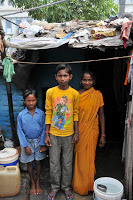 When it was time to leave, the family walked us back to the road, with me holding hands with little Sikander. To the left, and covering the length of the entire slum, ironically, is the World Health Organization’s massive, modern, city-block size building. WHO of course is responsible for monitoring and improving the health conditions of developing countries. Just one hundred feet away, its gleaming windows, satellite dishes and massive height dwarfed the pitiful slum. A pretty employee scurried into the building, ignoring us and the ill-dressed impoverished people with us. To add insult to injury, the guards yelled at our driver for daring to park in their parking spot, which of course was empty, save us! Welcome to the world of institutionalized development.
When it was time to leave, the family walked us back to the road, with me holding hands with little Sikander. To the left, and covering the length of the entire slum, ironically, is the World Health Organization’s massive, modern, city-block size building. WHO of course is responsible for monitoring and improving the health conditions of developing countries. Just one hundred feet away, its gleaming windows, satellite dishes and massive height dwarfed the pitiful slum. A pretty employee scurried into the building, ignoring us and the ill-dressed impoverished people with us. To add insult to injury, the guards yelled at our driver for daring to park in their parking spot, which of course was empty, save us! Welcome to the world of institutionalized development.
We journeyed on to the next home, where my sponsored child lives. This is my third trip to see Suraj Tanti and his family. I first met them in 2001 and we have maintained a wonderful relationship since. The father, Anil, writes to me several times a year, keeping me updated with the children’s progress, and sending their photos. There are three kids: Suraj (19, but who looks about 14)), Chanda (14) and Shashi (12). Their mother Anita, ever smiling, was also present. Shashi inside the 10 x 10 ft dwelling
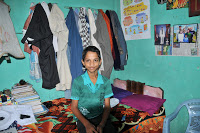 We ambled down the broken cement path to their home, populated by random goats, and lined with open run offs, through which ran dirty water and sewage. Despite living in a slum, the Tanti family keeps itself immaculately clean. I actually knew some of the way to their house, and recognized the familiar cement walls, wire fence and neighborhood. Their home is also a one room concrete dwelling, with tin roof and nothing inside but a hard board to serve as a bed— no mattress to ease throbbing joints— and one chair. That’s it. It’s the size of a closet.
We ambled down the broken cement path to their home, populated by random goats, and lined with open run offs, through which ran dirty water and sewage. Despite living in a slum, the Tanti family keeps itself immaculately clean. I actually knew some of the way to their house, and recognized the familiar cement walls, wire fence and neighborhood. Their home is also a one room concrete dwelling, with tin roof and nothing inside but a hard board to serve as a bed— no mattress to ease throbbing joints— and one chair. That’s it. It’s the size of a closet.
Since this was my third trip, and since we’ve maintained contact through the years, all shyness has melted away and we are now very comfortable with one another. “How are your children?” Suraj asked in perfect English. That made me happy! Shashi piped in, “And Jak?” (our terrier) We hauled out the photo albums they keep under the bed, and looked through all the family photos I have sent them through the years.
Shahsi was having a bleed, but never complained. I left factor with them, about $10,000 worth (equal to over ten years salary for Anil), as I know the father is highly responsible. A local doctor can administer when needed. This saves them all a very long trip to the hospital. We then took a short walk to the little shop where Anita sells candy, small cakes and pens. It earns next to nothing; Save One Life sponsorships really help keep them going.
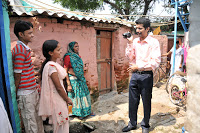
We had a bittersweet good-bye: I was so happy to have visited, but we knew it would be some time before I returned. Indians normally do not hug in public, but we made some exceptions for the American guest!
We relaxed a bit back at the house, and took lunch with Magi, and her adult daughter. All the food is delicious, including the wonderful staple roti (bread), and there is nothing like Indian desserts—all sweet and milk-based. The family’s hospitality puts a great face to India.
After such a day, we were not done still: Usha and I packed up, parted with many good-byes, and headed out to catch the 6:00 flight to Trivandrum, on the south western tip of the sub-continent. We flew for four hours, an easy flight, arriving at 10:00 pm. Tropical breezes greeted us, along with Joe, the tall, handsome son of George Tharakan, a man with hemophilia and one of the founders of the Hemophilia Federation. Off to the hotel for a long night’s sleep.
India is an amazing country with huge potential. By all rights it could be a superpower, given its young and increasingly well- educated people, which is one of its best resources. But it’s hampered also by its huge population, much of which lives under the poverty line, and by a government that has other priorities. We’re seeing progress in hemophilia, at the government level, and also at the patient level, through programs like Save One Life.
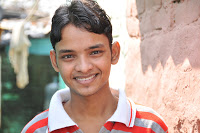


4 thoughts on “India Day 2: Slumdogs to WHO?”
It is so paining to see the state of children with hemophilia. But God has given them a reservior of determination and hope. Keep on doing the good works Laurie because YOU are their saviour. God bless you.
I really admire your dedication to helping impoverished hemophilia patients. You are a true hero of mine Laurie Kelley!
Laurie is the "Mother of all Persons with Hemophilia" around the world.
Kudos!
– Ujjwal Bhattarai, CT
George Tharakan is not with us anymore. He passed away yesterday, 23rd FEb 2013.